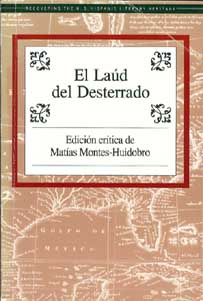2.1.5.1 “The Exile’s Lute” published in 1858, the poets included in the sample

This compilation was published in New York in 1958. Many of the poetic pieces it includes belong to authors who are addressed individually, but as an artistic body it possesses holistic properties that cannot be reduced to a mere sum of poems, but rather a more transcendent value within the development of Cuban lyric poetry, insofar as it signified the assumption of a political position within a careful aesthetic framework.
Six of the seven poets whose works were collected in this kind of anthology—José María Heredia being the exception—identified themselves with an annexationist position, an ideological movement that would reach its peak around this time. This should be interpreted more as part of the ideological chaos that gave way to separatism and not as a goal that would endure in the consciousness of 19th-century intellectuals.
According to Matías Montes Huidobro: “Al Lud del Desterrado can be considered a precursor to the reasons and character of an entire movement of Cuban literature that has developed in the United States to this day. It created a political-literary tradition that is part of our future as a nation and is a formative element of our nationality and our literature. Leaving, leaving, escaping from slavery or suffocation, is a tradition with a historical genetic makeup among Cuban writers.”
The collection included poems by Miguel Teurbe Tolón (1820 – 1857), Leopoldo Turla (1818 – 1877), Pedro Ángel Castellón (1820 – 1856), Pedro Santacilia (1826 – 1910), José Agustín Quintero (1829 – 1885) and Juan Clemente Zenea (1832 – 1871). It also included well-known pieces by José María Heredia (1803 – 1839), who had died several years before but the independence symbolism of his verses remained vivid and predictive. The first work to appear is precisely “Himno del Desterrado” (Hymn of the Exile).
Two to five compositions by each author are included, and twenty by Miguel Teurbe Tolón as a posthumous tribute. The works present uneven aesthetic quality, with those by Heredia and Juan Clemente Zenea always standing out, but they all share a superior expressive purpose. From a distance, they convey a patriotism constantly fueled by the conditions of exile, a distance they sought to conjure in their verses, creating oases of Cuban culture in the midst of a land that would, over time, become such a exporter of cultural models.
The editor’s original introduction makes the ultimate purpose explicit: “The title of this work perfectly explains its purpose. We wanted to offer in a few pages a demonstration of the work, of the talent for the cause of our revolution, and at the same time we think of rendering a notable service to the Cuban people by making the melancholic voice of their exiled poets resonate through the press once again (…) There will be no shortage of judicious readers for these pages and we cherish the hope that there will be more than one holy tear to bathe some flowers that were born under the foreign sun in the always sad days of one of the most painful emigrations in the political history of our homeland.”
Some poets, rather than expressing an independence creed that could even be shared by pacifists, sang a true war song from the lute, as evidenced in the following fragment of a poem by Miguel Teurbe Tolón:
“Oh! Will the Cuban ever dare,
To regain lost freedom,
To raise the forehead, and in the feared fight
“Freedom! Freedom!” he cried proudly,
With lance in hand or with sword in hand?
Wake up, by God! Long days!
The woe of the infamous slave alone
The echoes of this land repeated.
Our anger roars
“Let the bronze resound now! Let the war thunder!”
This poetic selection was undoubtedly one of the most advanced works of its time, as many of the pieces it includes were already inscribed in the dawn of the second Romantic generation. From a political perspective, it was also characterized by the separatist outlook it held, with an approach—although it cannot be considered unitary due to the multiplicity of authors—that encouraged the struggle for freedom. The nostalgia for exile, heightened by the impossibility of return, gives these pages a more authentic patriotic spirit than that found in other texts.








